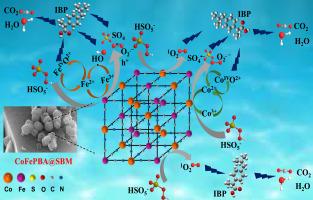CoFe Prussian blue analogue nanospheres doped on porous biochar for enhanced ibuprofen degradation via peroxymonosulfate activation
IF 7.7
2区 环境科学与生态学
Q1 ENVIRONMENTAL SCIENCES
引用次数: 0
Abstract
The environmental presence of ibuprofen (IBP), a widely used non-steroidal anti-inflammatory drug, poses significant risks due to its incomplete metabolism and high toxicity of derivatives. This study presents an innovative approach using cobalt-iron Prussian blue analogues (CoFePBA) immobilized on porous biochar (SBM) for the degradation of IBP via peroxymonosulfate (PMS) activation. The synthesized CoFePBA@SBM catalyst exhibited superior physicochemical properties, including high specific surface area, robust structural stability, and abundant active sites, as characterized by SEM, TEM, XPS, and XRD analyses. The catalytic efficiency of CoFePBA@SBM in activating PMS was systematically evaluated under varying operational parameters, demonstrating remarkable IBP removal efficiency (up to 95.9 %) across a wide pH range. Mechanistic investigations revealed that both radical (SO4•−, HO•, O2•−) and non-radical (1O2) pathways contributed significantly to the degradation process, supported by quenching experiments, EPR analysis, and DFT calculations. The proposed degradation pathways were elucidated through LC-MS, highlighting adequate mineralization into CO2 and H2O with minimal byproduct toxicity. The CoFePBA@SBM catalyst exhibited excellent recyclability and stability over ten cycles, with minimal metal leaching, complying with WHO guidelines. These findings underscore the potential of CoFePBA@SBM as a sustainable solution for mitigating antibiotic contamination in aquatic environments.

多孔生物炭上掺杂的铜普鲁士蓝模拟纳米球通过过氧单硫酸盐活化增强布洛芬的降解。
布洛芬(IBP)是一种广泛使用的非甾体抗炎药,由于其代谢不完全和衍生物的高毒性,在环境中存在严重的风险。本研究提出了一种利用多孔生物炭(SBM)固定化钴铁普鲁士蓝类似物(CoFePBA)通过过氧单硫酸盐(PMS)活化降解IBP的创新方法。通过SEM、TEM、XPS和XRD分析,合成的CoFePBA@SBM催化剂具有比表面积高、结构稳定性强、活性位点丰富等优异的理化性能。在不同的操作参数下,系统地评估了CoFePBA@SBM活化PMS的催化效率,在很宽的pH范围内显示出显著的IBP去除效率(高达95.9%)。机理研究表明,自由基(SO4•-、HO•、O2•-)和非自由基(1O2)途径对降解过程都有显著贡献,这得到了淬火实验、EPR分析和DFT计算的支持。通过LC-MS阐明了所提出的降解途径,强调充分矿化成CO2和H2O,副产物毒性最小。CoFePBA@SBM催化剂在10次循环中表现出优异的可回收性和稳定性,金属浸出最小,符合世卫组织准则。这些发现强调了CoFePBA@SBM作为减轻水生环境中抗生素污染的可持续解决方案的潜力。
本文章由计算机程序翻译,如有差异,请以英文原文为准。
求助全文
约1分钟内获得全文
求助全文
来源期刊

Environmental Research
环境科学-公共卫生、环境卫生与职业卫生
CiteScore
12.60
自引率
8.40%
发文量
2480
审稿时长
4.7 months
期刊介绍:
The Environmental Research journal presents a broad range of interdisciplinary research, focused on addressing worldwide environmental concerns and featuring innovative findings. Our publication strives to explore relevant anthropogenic issues across various environmental sectors, showcasing practical applications in real-life settings.
 求助内容:
求助内容: 应助结果提醒方式:
应助结果提醒方式:


